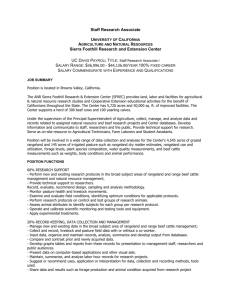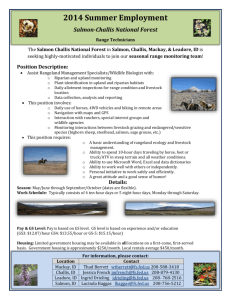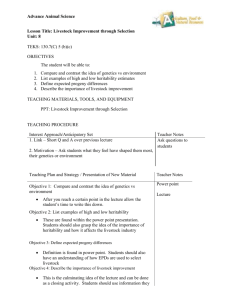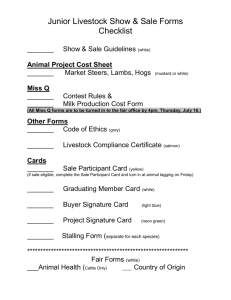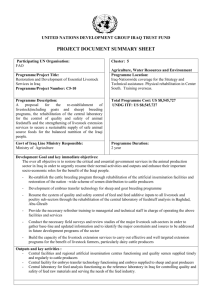Case Study Example - START - SysTem for Analysis Research and
advertisement
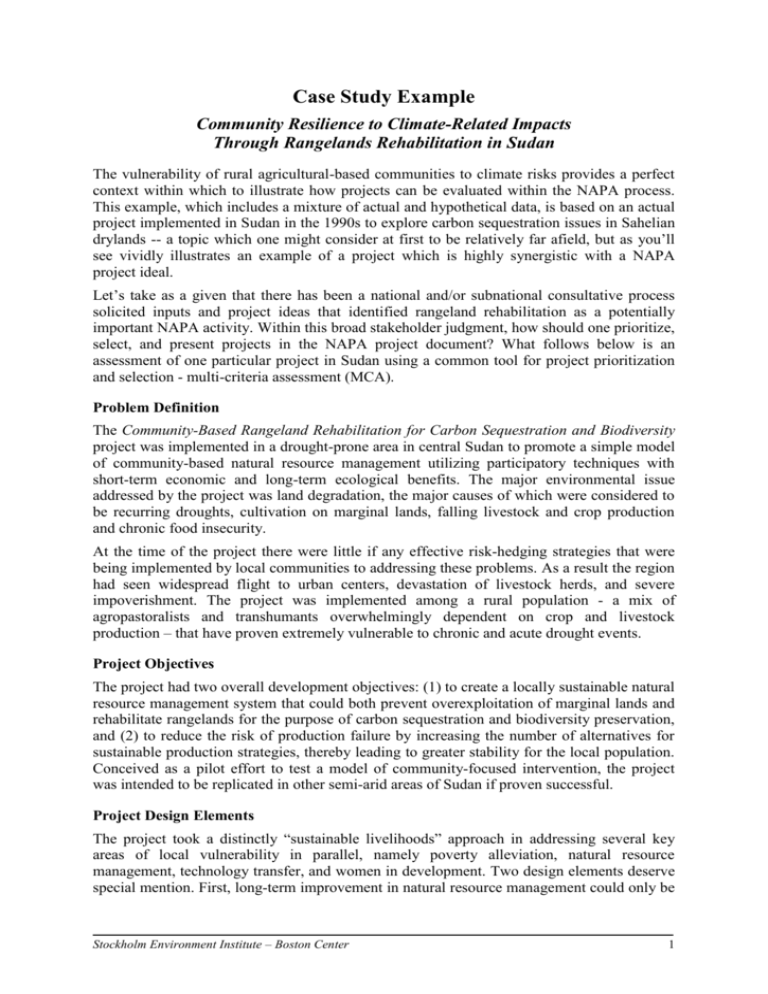
Case Study Example Community Resilience to Climate-Related Impacts Through Rangelands Rehabilitation in Sudan The vulnerability of rural agricultural-based communities to climate risks provides a perfect context within which to illustrate how projects can be evaluated within the NAPA process. This example, which includes a mixture of actual and hypothetical data, is based on an actual project implemented in Sudan in the 1990s to explore carbon sequestration issues in Sahelian drylands -- a topic which one might consider at first to be relatively far afield, but as you’ll see vividly illustrates an example of a project which is highly synergistic with a NAPA project ideal. Let’s take as a given that there has been a national and/or subnational consultative process solicited inputs and project ideas that identified rangeland rehabilitation as a potentially important NAPA activity. Within this broad stakeholder judgment, how should one prioritize, select, and present projects in the NAPA project document? What follows below is an assessment of one particular project in Sudan using a common tool for project prioritization and selection - multi-criteria assessment (MCA). Problem Definition The Community-Based Rangeland Rehabilitation for Carbon Sequestration and Biodiversity project was implemented in a drought-prone area in central Sudan to promote a simple model of community-based natural resource management utilizing participatory techniques with short-term economic and long-term ecological benefits. The major environmental issue addressed by the project was land degradation, the major causes of which were considered to be recurring droughts, cultivation on marginal lands, falling livestock and crop production and chronic food insecurity. At the time of the project there were little if any effective risk-hedging strategies that were being implemented by local communities to addressing these problems. As a result the region had seen widespread flight to urban centers, devastation of livestock herds, and severe impoverishment. The project was implemented among a rural population - a mix of agropastoralists and transhumants overwhelmingly dependent on crop and livestock production – that have proven extremely vulnerable to chronic and acute drought events. Project Objectives The project had two overall development objectives: (1) to create a locally sustainable natural resource management system that could both prevent overexploitation of marginal lands and rehabilitate rangelands for the purpose of carbon sequestration and biodiversity preservation, and (2) to reduce the risk of production failure by increasing the number of alternatives for sustainable production strategies, thereby leading to greater stability for the local population. Conceived as a pilot effort to test a model of community-focused intervention, the project was intended to be replicated in other semi-arid areas of Sudan if proven successful. Project Design Elements The project took a distinctly “sustainable livelihoods” approach in addressing several key areas of local vulnerability in parallel, namely poverty alleviation, natural resource management, technology transfer, and women in development. Two design elements deserve special mention. First, long-term improvement in natural resource management could only be Stockholm Environment Institute – Boston Center 1 achieved if accompanied by activities that met near term community needs. For this reason, numerous measures were implemented that directly addressed socio-economic conditions rather than carbon sequestration per se. These included village-level irrigated gardens, handicrafts and food processing, water point development, livestock restocking, soap production, revolving credit systems, village-level fodder production, animal health management/training, household macaroni production, pest management, and drought contingency planning. Second, community-based participation was an essential approach to improving rangeland management. This led to an implementation strategy that relied on existing, traditional mechanisms of leadership, social discipline, alliances and reciprocity between tribes that used the same land resources. Potential Project Alternatives To meet the rangeland rehabilitation and risk reduction objectives of the project, a number of alternatives could have been considered. There were several potentially suitable project alternatives cited and discussed in the Project Document, as follows: a) gum-belt restocking, b) crop and livestock improvement activities, c) irrigated fodder production, and d) water point development. These were not considered in a multi-criteria assessment framework at the time of the project proposal. Each option has several advantages and disadvantages, and the application of the MCA process helps set these out clearly. For the sake of illustration, each is now considered in a MCA framework for possible suitability as a NAPA-compatible project. Project Criteria Selection An evaluation of alternatives using multi-criteria assessment techniques relies on a process of establishing relevant criteria, weighting those criteria, and then ranking results. This allows an evaluation of the effectiveness of the project and each alternative relative to the overall aim of reducing local vulnerability. The initial step in using this method is to convene a representative stakeholder group to identify suitable evaluation criteria. For illustrative purposes, four criteria are assumed to have been selected by a stakeholder group: agricultural production, livestock production, intervention cost, and community capital enhancement. These criteria fulfill the requirements of the MCA process in that they are relevant, distinct from each other, and stakeholder-driven. The list is certainly not exhaustive, and you should think about how the list could be appropriately expanded. In part, these criteria have been chosen because there are rough numerical estimates available, based on assorted project documents and government statistics. Of course, there is only one option available (i.e., the community rangeland rehabilitation project), but use of data means that each project alternative can be scored in terms of the criteria. Furthermore, by scoring on some kind of standardized basis, attributes that are readily quantifiable (such as annual millet yields) will not overwhelm other attributes that are more amenable to qualitative assessment (such as local capacity strengthening). Using an absolute scoring system for each criterion generates an MCA matrix as shown in Table 1 below. For simplicity, the “no-project” alternative is excluded. One can see from this table, for example, that the irrigated fodder production alternative has a higher agricultural production levels than any of the other alternatives. Stockholm Environment Institute – Boston Center 2 Table 1: Absolute criteria scores of the project and its alternatives Criteria agricultural livestock community production production Cost capital Alternative (tonnes) (# of sheep) (million $) (participants) rangeland rehabilitation 190 175 5 900 gum-belt restocking 175 0 50 20 crop/livestock improvement 135 35 202 50 irrigated fodder production 210 0 35 100 water point development 0 0 450 150 The outputs above are not much good to us in their present form. Standardizing will help us compare across criteria and projects. Using a standardization of 0 to 100 for each criterion generates an MCA matrix as shown in Table 2 below. One can see from this table, for example, that the irrigated fodder production alternative receives the highest (i.e., best) score when considered against the other alternatives for agricultural production. Table 2: Standardized criteria scores of the project and its alternatives Criteria agricultural livestock community Alternative production production Cost capital rangeland rehabilitation 91 100 100 100 gum-belt restocking 83 0 10 2 crop/livestock improvement 64 20 2 5 irrigated fodder production 100 0 14 11 water point development 0 0 1 17 Criteria Weighting As with the establishment of criteria, weighting also requires participation of stakeholders to make the process more inclusive. While this approach is more subjective than the earlier steps, which have been based on the application of government or project data, it is comparatively objective when compared to ad hoc, non-stakeholder-driven assessments. For the purposes of this case study, let’s assume that stakeholders have agreed that the prime function of the five risk-reducing alternatives is to build at the household level as well as the overall community level the ability to avoid crisis responses to future drought events. They have decided that the criterion that is most relevant to this function (i.e., community capital) should be weighted by a factor of three, and an equal weighting given to the other three criteria. When this weighting is inserted in the table, it has the effect shown on Table 3. Table 3: Weighted criteria scores of the project and its alternatives Criteria agricultural livestock community production production Cost capital Weighting factor >>> 16.3% 16.3% 16.3% 50.0% Alternative rangeland rehabilitation 14.8 16.3 16.3 50.0 gum-belt restocking 13.5 0 1.6 1.0 crop/livestock improvement 10.4 3.3 0.3 2.5 irrigated fodder production 2.7 0 2.3 5.5 water point development 0 0 0.2 8.5 Stockholm Environment Institute – Boston Center Total 100% 97.4 16.1 16.5 10.5 8.7 3 Discussion and Conclusions In this illustrative application, the multi-criteria assessment table indicates that the rangeland rehabilitation project is the “best” type of project, yielding a score of 97.4, which is nearly 6 times the score of its closest competing alternative, the crop/livestock improvement project. It is important to note that this result is a direct outcome of the stakeholder-driven set of criteria and weighting process. If, for example, agricultural production was considered a much more important criterion than community capital, then a far different result may have resulted. In fact, conducting sensitivity analysis on the weighting scheme – in close consultation with the stakeholder group – can be a very useful way of assessing the robustness of the conclusions. We recommend that such analyzes be conducted in any multi-criteria assessment. In conclusion, it is worth stressing several points. First, multi-criteria assessment techniques work most effectively when they increase transparency. To do this, involve stakeholders in decisions about criteria and weighting prior to filling the table with numbers. This will ultimately help promote donor confidence and hence facilitate the securing of necessary funds to implement the project. Second, the assessment process is used to provide insight into what will be a final investment decision. The MCA process is a “one shot deal” to guide the decision about which alternative is best. It is extremely important that the sensitivity of the results be thoroughly scrutinized to ensure confidence in the outcome. Third, multi-criteria assessment is logical and fairly straightforward to understand. This makes is readily explainable to others involved in the NAPA process. Its major strength is that it seeks to allocate responses objectively. When reinforced by effective participation of stakeholders in identifying criteria and determining weighting levels, the process becomes transparent and comparatively objective. Finally, multi-criteria assessment offers the means by which an established planning tool could be applied for use in NAPA project identification. It does, however, require availability of data as well as active participation by stakeholders to be effective. When such participation occurs, the process can increase transparency and by extension bilateral donor confidence. References Dougherty, W., Abusuwar, A., Abdel Razik, K., 2001. Sudan: Community-Based Rangeland Rehabilitation for Carbon Sequestration and Biodiversity SUD/93/G31, Report of the Terminal Evaluation, October. Least Developed Countries Expert Group (LEG), 2002. Annotated Guidelines for the Preparation of National Adaptation Programmes of Action, July. United Nations Development Programme, 1993. Sudan: Community-Based Rangeland Rehabilitation for Carbon Sequestration and Biodiversity, Project Document. Stockholm Environment Institute – Boston Center 4
